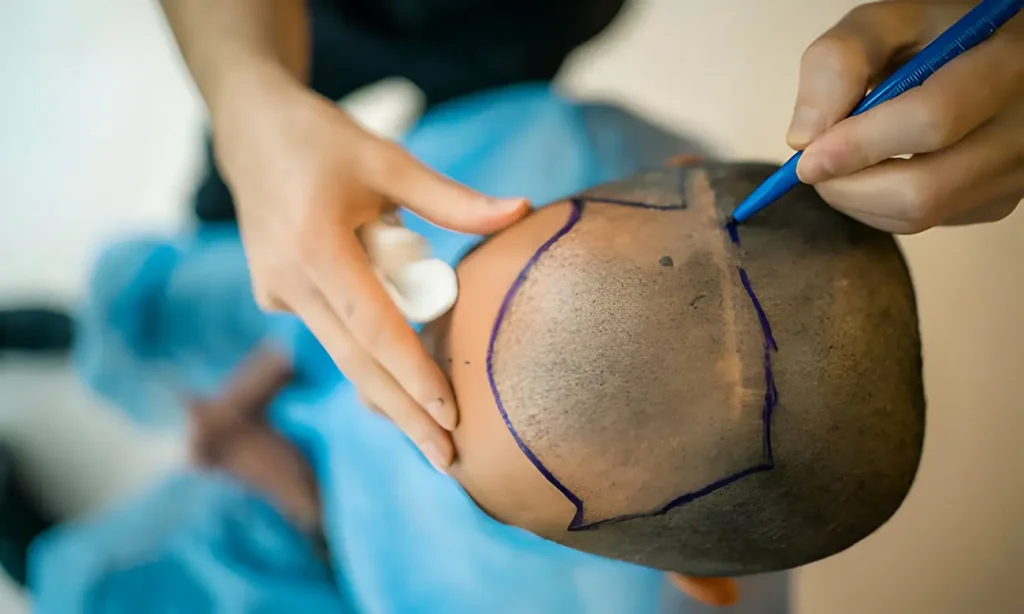Type and hit Enter to search
Experts in aesthetic surgery, dermatology, and beauty bring you the latest trends, research, and advice to help you make informed decisions about your appearance and health.
A web platform dedicated to aesthetic surgery, dermatology, and beauty, where expertise meets innovation, and your desires and needs become our mission. In a world where appearance and health go hand in hand, our platform leads the revolution, delivering the latest trends, research, and expert advice directly to you.
Our team consists of highly skilled professionals in the fields of aesthetic surgery and dermatology, committed to providing reliable information and guidance that will help you make informed choices about your appearance and well-being. We understand that every individual has unique needs and desires, which is why we approach each person with the utmost care and professionalism.
Powered by Aestetica Web Design © 2024
Robots on Your Head: Revolution in Hair Transplantation or Just Another Trend?
Have you ever dreamed of luscious locks without the hassle of hair transplants? Welcome to the future, where robots are taking matters into their own... hands? Well, maybe not hands, but definitely precise robotic arms! Forget outdated methods and join us as we explore how robots are changing the game in the world of hair transplantation. You might be surprised at how far this technology has come, and you might even want a robot to "pluck" your scalp a little.
Hair transplantation is nothing new. Even in ancient times, people experimented with various methods of hair transplantation, using everything from herbal remedies to animal hair. But it wasn’t until the 20th century, with the development of modern medicine, that hair transplantation became a serious medical procedure. The first significant advancements occurred in the 1950s, when Japanese doctors developed a technique for transplanting hair from one part of the body to another. This technique, known as FUT (Follicular Unit Transplantation), involved taking a strip of skin from the donor’s scalp and transplanting individual hair follicles to areas with thinning hair.
FUT was a revolutionary method, but it wasn’t without its drawbacks. Scars at the donor site, long recovery times, and the limited amount of hair that could be transplanted were some of the problems patients faced. But despite these challenges, FUT laid the foundation for the further development of hair transplantation.
In the 1990s, a new technique called FUE (Follicular Unit Extraction) emerged. FUE allowed for the extraction of individual hair follicles without the need for a strip of skin, significantly reducing scarring and recovery time. This method quickly gained popularity and became the gold standard in hair transplantation.
But humanity didn’t stop there. In the pursuit of even better, faster, and more precise solutions, scientists and engineers turned to robotics. At the beginning of the 21st century, the first robotic systems for hair transplantation appeared, promising a revolution in this field.
How Does It Actually Work?: A Detailed Description of the Robotic Hair Transplantation Process
Robotics has brought a new dimension of precision and efficiency to hair transplantation. The process of robotic hair transplantation, although it varies depending on the specific system, usually involves the following steps:
3D Scalp Mapping: The robot scans the patient’s scalp to create a detailed 3D map, identifying areas of hair loss and determining the optimal angles and directions of hair growth.
Follicle Extraction: The robot, guided by artificial intelligence algorithms, precisely extracts individual hair follicles from the donor area, usually from the back of the head.
Follicle Preparation: The extracted follicles are carefully prepared for transplantation, ensuring their vitality and optimal quality.
Follicle Implantation: The robot, following the previously created 3D map, implants the hair follicles into the areas of hair loss, ensuring a natural appearance and density.
This process, although technologically advanced, still requires the expertise and experience of a surgeon. The robot is a tool, and the surgeon is the one who makes the key decisions and oversees the entire procedure.
Meet the Robot: ARTAS and Other Players in the Market
There are several robotic systems for hair transplantation on the market, and one of the most well-known is ARTAS. This system, developed by the American company Restoration Robotics, uses advanced robotics and artificial intelligence to automate the hair transplant process. ARTAS is known for its precision, speed, and minimal invasiveness.
In addition to ARTAS, there are other robotic systems such as NeoGraft and SmartGraft, which also offer automated follicle extraction and implantation. Each system has its own advantages and disadvantages, and the choice of the best one depends on the individual needs of the patient and the preferences of the surgeon.
The Price of Progress: Is Robotic Hair Transplantation for Everyone?
Robotics has brought numerous advantages to hair transplantation, but that doesn’t mean this method is accessible to everyone. The cost of robotic hair transplantation is often higher than traditional methods, due to the high costs of technology and surgeon training. In Croatia, the price of robotic hair transplantation can vary depending on the clinic, the number of follicles transplanted, and other factors, but it usually ranges from several thousand to tens of thousands of euros.
While price is one factor that can limit access to robotic hair transplantation, it’s important to note that this method can be a worthwhile investment for some patients. Faster recovery, smaller scars, and better results can justify the higher price for those who can afford it.
Precision is the Name of the Game
In the world of hair transplantation, precision is key. Each hair follicle must be carefully extracted and implanted at the right angle and direction to achieve a natural look and optimal hair density. This is where robotics comes into play. Robots, unlike human hands, don’t shake, don’t get tired, and don’t lose concentration. They can perform complex tasks with incredible precision and consistency, which is vital for the success of hair transplantation.
Studies have shown that robotic hair transplantation can achieve greater precision in follicle extraction and implantation compared to traditional methods. This means less damage to the follicles, a higher survival rate of transplanted hair, and a more natural look. Additionally, robots can analyze the characteristics of each hair follicle and select the highest quality ones for transplantation, further increasing the chances of success.
Faster, Better, Stronger?
Time is money, and that applies to hair transplantation as well. Robotics allows for faster extraction and implantation of hair follicles compared to traditional methods, which shortens the duration of the procedure and reduces discomfort for the patient. In addition, robotic hair transplantation often results in faster recovery and less visible scarring, allowing patients to return to their daily activities sooner.
While it’s still too early to draw definitive conclusions, some studies suggest that robotic hair transplantation may yield better results in terms of hair density and naturalness compared to traditional methods. However, further research is needed to confirm these findings.
Robots Aren’t Perfect
Despite the numerous advantages, robotic hair transplantation is not a magic wand. There are certain limitations and risks that need to be considered. For example, robots are still not able to make decisions independently and adapt to unexpected situations. Therefore, the role of the surgeon, who supervises the robot’s work and intervenes when necessary, is crucial.
Furthermore, robotic hair transplantation may not be the best choice for all patients. For example, individuals with certain medical conditions or types of hair loss may be better candidates for traditional methods. Also, robotic hair transplantation can be more expensive than traditional methods, which is an important factor for many patients.
Ethical Issues and the Future of Robots in Medicine
The use of robots in medicine, including hair transplantation, raises numerous ethical questions. What is the role of the surgeon in robotic surgery? Who is responsible for any complications? How to ensure that patients receive all the necessary information to make an informed decision about treatment?
In addition to ethical issues, there are technical challenges that need to be overcome. Robotics is rapidly evolving, but there are still limitations in terms of flexibility, adaptability, and decision-making ability. How will robots be integrated into the existing healthcare system? Will they replace surgeons or work alongside them?
The future of robots in medicine is uncertain, but one thing is for sure: they will play an increasingly important role in providing healthcare.
Consultation and Planning for Robotic Hair Transplantation
The journey to new hair begins with a consultation with a surgeon specializing in hair transplantation. This first meeting is crucial for assessing your condition, understanding your expectations, and creating a personalized treatment plan. The surgeon will examine your scalp in detail, assess the density and quality of your hair, and determine the cause of your hair loss. They will also inform you about the different treatment options, including robotic hair transplantation, and help you choose the best option for you.
In addition to consulting with the surgeon, it’s important to have some tests done before the procedure. This may include blood tests, allergy testing, and other tests that will help the surgeon assess your health and ensure a safe and successful outcome of the surgery.
Meet Your Surgeon… and the Robot
On the day of the procedure, you will be greeted by a team of experts, including the surgeon and the technician who will operate the robotic system. Before the procedure begins, you will receive local anesthesia to ensure painlessness during the procedure. Then the robot, guided by the surgeon, will begin extracting hair follicles from the donor area. This process is usually quick and painless, and thanks to the precision of the robot, the risk of follicle damage is minimal.
After the extraction of the follicles, their implantation into the areas of hair loss follows. The robot will precisely place each follicle at the right angle and direction, ensuring a natural look and optimal hair density. This process can take several hours, depending on the number of follicles transplanted.
Recovery and Care
After the procedure, you can expect mild redness and swelling on the scalp, but this is normal and usually subsides within a few days. It’s important to follow the surgeon’s instructions for scalp care after the procedure, which may include washing with a special shampoo, avoiding sun exposure and physical activity, and taking prescribed medications.
Most patients can return to their daily activities within a few days after the procedure, but it’s important to avoid strenuous activities and sun exposure for a few weeks. Also, it’s important to visit the surgeon regularly for check-ups and to monitor progress.
When Will the Results Be Visible?
Patience is key when it comes to hair transplantation. The first results are usually visible after a few months, but the final results may not be expected until a year later. It’s important to have realistic expectations and understand that hair transplantation is not a magic wand. While it can significantly improve appearance and self-confidence, it cannot completely stop hair loss.
Regular hair and scalp care, a healthy diet, and avoiding stress can help maintain the results of hair transplantation and promote new hair growth.
What Do the Experts Say?
The opinions of experts on robotic hair transplantation are divided, which is expected given the relative novelty of this technology. Some surgeons praise the precision and efficiency of robots, emphasizing that they can achieve results that the human hand simply cannot. Others are more cautious, highlighting the importance of the human factor in making key decisions and adapting the procedure to the individual needs of the patient.
“Robotics has undoubtedly brought progress to hair transplantation,” says Dr. [Name of expert], a leading hair transplant specialist in Croatia. “However, it’s important to emphasize that robots are not a substitute for the surgeon, but a tool that helps them achieve better results.”
On the other hand, some experts express concern about the potential dehumanization of medicine and the loss of contact between doctors and patients. “Robotics has its place in medicine, but we must not forget that hair transplantation, like any other medical procedure, is first and foremost a human interaction,” warns Dr. [Name of another expert], an ethicist specializing in medical technology.
Patients Have Their Say
The experiences of patients who have undergone robotic hair transplantation are diverse, but most report a high degree of satisfaction. Many praise the speed and painlessness of the procedure, as well as the quick recovery and minimal scarring. Also, most patients emphasize the naturalness of the results and their satisfaction with the new look of their hair.
“I was skeptical at first, but the results amazed me,” says [Patient’s name], who underwent robotic hair transplantation a year ago. “My hair looks completely natural, and the scars are barely visible. I would recommend this method to anyone considering hair transplantation.”
Of course, there are also patients who are not entirely satisfied with the results. Some mention that they did not achieve the expected hair density, while others report mild side effects such as itching and redness of the scalp. However, such cases are rare and can usually be resolved with additional treatments.
What Does the Future Hold?
Robotics in hair transplantation is still in its early stages of development, but the potential is enormous. With advancements in artificial intelligence and machine learning, robots will become increasingly precise, efficient, and adaptable. It is possible that in the future, robots will be able to perform the entire hair transplant procedure independently, without the need for human intervention.
Additionally, robotics could enable the development of new, minimally invasive hair transplant methods that would be even faster, safer, and more effective. Also, robots could help personalize treatment, tailoring the procedure to the individual characteristics of the patient and ensuring optimal results.
Final Verdict: Is Robotic Hair Transplantation Worth the Investment?
Robotics has undoubtedly revolutionized hair transplantation, offering numerous advantages over traditional methods. Precision, speed, minimal invasiveness, and natural results are just some of the benefits that attract an increasing number of patients.
However, robotic hair transplantation is not a magic wand and is not for everyone. The high price, limited availability, and the need for expert supervision by a surgeon are some of the factors to consider before deciding on treatment.
The final verdict on the value of robotic hair transplantation depends on the individual needs and priorities of the patient. For those seeking the latest technology, precision, and quick recovery, robotic hair transplantation can be an excellent investment. However, for those with a limited budget or specific medical conditions, traditional methods may be a better choice. In any case, it’s important to consult with an expert to get all the necessary information and make an informed decision about the best treatment option for you.
Biography of Dr. Gorana Kuka Epstein
Dr. Gorana Kuka Epstein is a specialist in plastic and aesthetic surgery. She is a professor at the Miami University School of Medicine, a diplomate of the American Board of Hair Restoration Surgery, and a doctoral candidate at the Faculty of Medicine at the University of Novi Sad. Dr. Kuka Epstein is the founder and director of the FoundHair Training program, the founder of the Center for the Treatment of Female Hair Loss, the director of the research department at the Foundation for Hair Restoration in Miami, and the founder of the Dr. Gorana Kuka Foundation.
Reference





